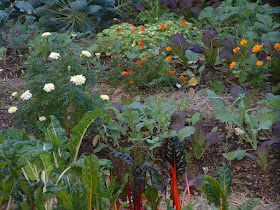The spring temperatures will soon be settled and it will be safe to plant your summer garden. If you have focused mostly on growing tomatoes, peppers and other favorite vegetables, consider adding some flowers to your garden. Not only will flowers add a splash of color and interest, but they can serve a significant role in providing nectar and pollen for pollinating insects, and attracting these insects will in turn help to pollinate your vegetables.
Here are a few tips to help you choose the best flowers to add to your vegetable garden. You can start small and add a few but keep notes as to which flowers you found brought the most pollinators, those that you enjoyed for their added color and texture and also those that worked well in your climate:
- First determine the hardiness zone where you live. It is very easy to find by going to the USDA links such as this one: http://planthardiness.ars.usda.gov/PHZMWeb/# or call your local Extension Service office. It is important to know your zone in order to choose the plants that will thrive in your climate. Always check the seed packet or the plant tag to see which zone it grows best in, and avoid those that are outside of your zone for best performance. There are some stores that sell plants that may be suited for other zones and would not perform well in your garden.
- A reliable source for finding durable plants is the Plant Select site: http://plantselect.org. The plants listed on this site have been tested in trial gardens at the Denver Botanic Gardens and at Colorado State University gardens. This is an excellent resource for the Colorado gardener to help select the right plant for the right place and great to use if you are new to the area and need help in finding the best plants for your garden.
- If this is your first try at adding flowers, start with just a few varieties that are known to be hardy and easy to grow such as zinnias, marigolds, coreopsis, cosmos and sunflowers. Native wildflowers also are an excellent choice because they are generally easy to grow and provide the food needed for the local native pollinators.
- Planting flowers that will bloom at various times of the season will provide ongoing food for the pollinators and wildlife as well and keep color and texture interest going in your garden for as long as possible. Some insects emerge in the early spring looking for food and continue to forage through the fall, so include flowers that start to bloom early such as spring bulbs and add others that can bloom early, mid and late season for continual bloom all season long.
- There are some new plants that have been developed by the floral industry to produce little to no pollen. The goal of course was to help their customers eliminate the mess of pollen falling from their cut flowers onto furniture or clothing, or to help those who may want flowers but have pollen allergies. However, without pollen these types may do little to attract beneficial insects into your garden. Check the seed packet or plant tag to see if they are listed as low or no pollen types.
- Companion planting has also been tested for many decades which is interplanting different crops and flowers to help with insect damage and increase yields. This bulletin explains how to companion plant which may guide you on which flowers to add to your vegetable garden: http://csuhort.blogspot.com/search/label/companion%20planting
This year try adding a few flowers to your vegetable garden and make keep notes as to which flowers worked best, attracted the most pollinators and that added visual enjoyment to your garden. The bulletins below will help you learn more about the role of flowers in your garden and the ones that will bring you enjoyment all season long:
